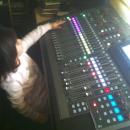#15
Correcto
Correcto

Alee escribió:no es lo mismo una señal cuadrada (suma de sinusoidales impares) que sigue siendo corriente alterna, a señal saturada que manda corriente continua

Manelfunk escribió:
En principio, no hay problema. Si te suena a poco y empiezas a subir el nivel de señal, puedes llegar a saturar la etapa. sonará saturado, o se activarán las protecciones de la etapa (las que tenga). Obviamente, si fuerzas el sistema hasta el absurdo y la etapa no tiene sistemas de protección, se podría estropear por temperatura. Los altavoces no deberían sufrir daños en este caso.



Manelfunk escribió:Una guitarra distorsionada se parece mucho a una senoide recortada. Básicamente se trata de eso, de una señal parecida a una senoide (la suma de unas senoides en realidad, la fundamental de la nota tocada y sus armónicos)

eliezer escribió:En mi caso estoy con la idea de amplificadores con doble de potencia RMS que los altavoces para mejor equilibrado de potencia eficaz real.
eliezer escribió:No creo que el caso de la guitarra sea un buen ejemplo en este caso.
Regístrate o identifícate para poder postear en este hilo